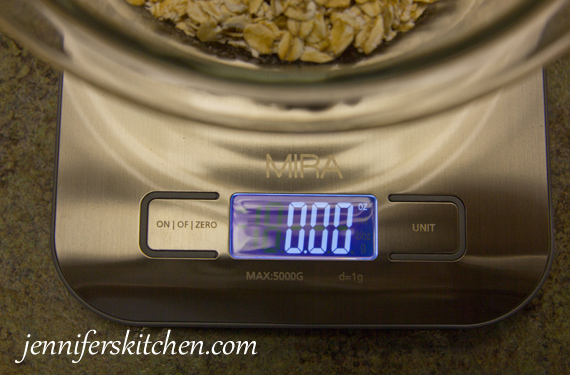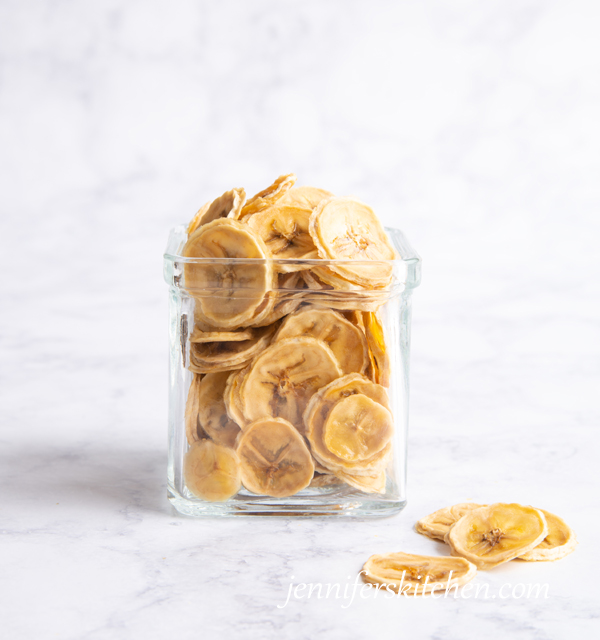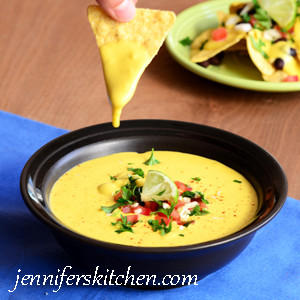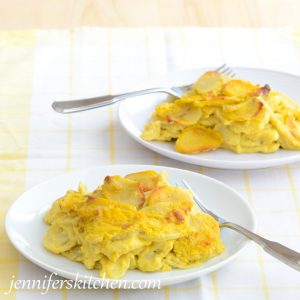Weighing It Out

I’ve avoided using a kitchen scale for years because I always thought that cooking by weight was for professional bakers and it also seemed like a lot more trouble than using a simple measuring cup or measuring spoon. Until I actually got a kitchen scale and realized that the exact opposite is true. There are so many advantages of using a kitchen scale for cooking and it’s perfect for normal, everyday cooks and cooking.
1. Less Messy
Cooking with a scale is less messy. Peanut butter, oil, honey, molasses, caramel, coconut cream, mayonnaise, tomato sauce = sloppy measuring cups and sticky measuring spoons.
But with a scale, you simply place the bowl on the scale, pour the first ingredient straight from the container into the bowl until the scale displays the right amount, push the tare button to bring the readout back to zero, pour the next ingredient right from the bag into the same bowl, and so forth.

One bowl. No measuring utensils. No oily or sticky mess.
Which reminds me of my very favorite part about cooking with a kitchen scale …
2. Fewer Dishes to Wash!!!
I like to cook, but washing dishes … no thanks. When you cook with a scale, usually all you need is one bowl and one mixing spoon. I love it!
3. Saves time
Because you don’t have to waste time searching for the right size measuring cup or spoon, measuring out ingredients, and washing dishes, you can be a faster cook and spend less time in the kitchen and more time doing what you really want to be doing.
Being able to pour the ingredients directly into the mixing bowl or pan comes in really handy when making large batches.
4. Fewer Mistakes
The other day in the middle of making Wonderful Waffles my phone rang. When I went back to the waffles, I thought, “Did I put all of the oats in? Or did I only put in 1 cup?” If I had been using my kitchen scale, all I would need to do is look at the weight display.
5. Easier to double or half recipes (or cut recipes into thirds or fifths for that matter)
All you mathematicians go to the next point. For the rest of us, have you ever tried to make one and a half recipes of a dish that called for 1/3 cup of sugar? Even if you have a calculator, it’s still not simple. It’s so much easier to adapt a recipe that calls for 100 grams of an ingredient.
6. Much more accurate
If I asked you to measure one cup of flour, and then I asked 9 other people to measure one cup of flour, we could very possibly end up with 10 different amounts. In fact, studies have shown the amount can range from as little as 4 ounces to as much as 6 ounces. Now this won’t make a big difference with some recipes, but for others it can mean the difference between success and failure. You could end up with muffins that are heavy, bread that falls, cake that’s gooey in the middle, or waffles that are dry.
Once I watched my friend making a dessert that called for 1 cup of caramel. When she dumped the caramel into the mixing bowl, I am quite sure she left about 1/4 cup of caramel in the measuring cup. I don’t blame her because that gooey stuff is a bother to scrape out of a measuring cup (and much more fun to lick out), so the recipe really should have called for 1 1/4 cups of caramel, right?
Anyway, what I’m trying to say is because ingredients go straight into your bowl when using a kitchen scale, there’s none wasted in the measuring cup and your recipes will be more accurate.
Measuring cups will never deliver the accuracy of a digital scale.
Using Weight Instead of Volume
Most recipes (including my recipes on this site) are in US standard measurements (teaspoons, tablespoons, cups, quarts, etc.); however, as cooks and recipe writers are beginning to see the value of cooking by weight instead of volume, more and more recipes are being published with both volume and weight measurements. I’m loving my scale so much, I may do the same.
What to Look for in a Kitchen Scale
Large Display – Choose a scale with an easy-to-read display so you know what your measurement is at a glance.
U.S. and metric units – I like a scale that can be easily switched between metric (grams) and U.S. (pounds and ounces) measurements without turning the scale over (so I can switch while there is a bowl on the scale).
Tare – In order to measure ingredients directly in the bowl rather than with a measuring utensil, the kitchen scale needs to have a tare function. If you push the tare button, the scale subtracts the weight of the bowl or pan on the scale so when you pour your first ingredient in you’re only getting the weight of the ingredient (not the bowl). Then if you push the tare button again, the scale will go back to zero again, and you can pour the next ingredient in and only get the weight of that ingredient (not the bowl and the first ingredient).

I have a Mira kitchen scale and it has all of these wonderful features, plus an auto shut off (for when I get distracted or sidetracked- which is just about every time I’m cooking something), a low battery indicator (so it doesn’t stop functioning midway through a recipe), and a smooth, easy to clean surface. I really like it. The only thing I’d change about it is it would be nice if it were a tiny bit bigger. (It’s been compared to an IPad Mini around here.) Then again, the small size means it doesn’t take up much space and is easy to store.
You my also like:





This is excellent information. I never understood why people would want to weigh the ingredients instead of measuring them, but now it all makes sense. And it seems so simple. So now we have to get other recipe writers to get on board with this. In the meantime, though, your handy cheat sheet will definitely be. . . handy.
P.S. I wish I were as smart as you!